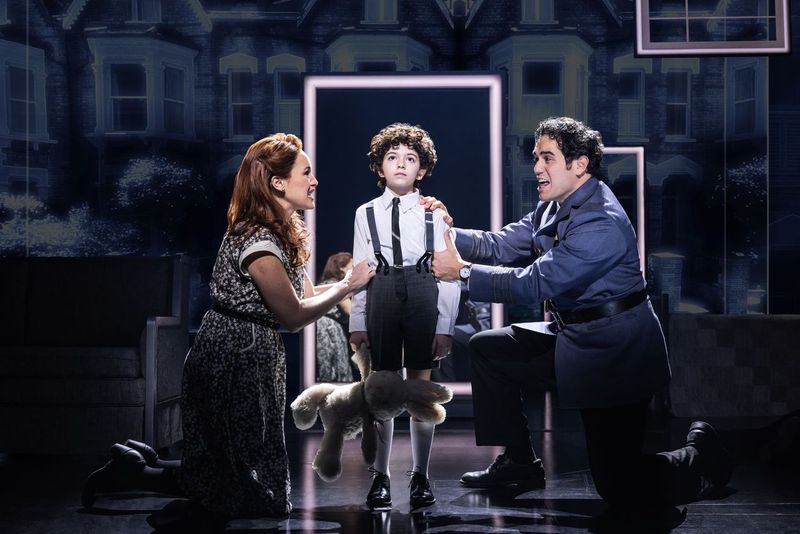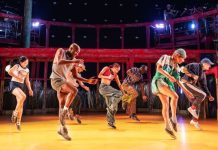When the English rock band The Who released the groundbreaking double album of their original rock opera Tommy in 1969, written primarily by guitarist Pete Townshend and inspired in part by his own childhood experiences, it became one of the most influential in the genre, went on to sell more than 20 million copies, and was inducted into the Grammy Hall of Fame in 1998. The recording was also adapted into the 1975 movie starring The Who’s lead singer and co-founder Roger Daltrey, and in 1993, a quarter-century after the album’s release, a stage adaptation made its debut on Broadway, winning five Tony Awards for the show and a Grammy for the original cast recording. The Who’s Tommy has now returned to Broadway, in a new production at the Nederlander Theatre, following its record-breaking award-winning premiere in Chicago, with Townshend (music, lyrics, and book) and Des McAnuff (direction and book) reuniting to bring the epic rock musical back to NYC for a current audience.

The reworked story follows the journey of Tommy Walker, who, as a four-year-old child in London, witnessed his long-absent father, who went missing in WWII, return home and shoot his mother’s lover – a trauma that renders him deaf, blind, and unable to speak, abused by members of his family, and bullied by the other kids. While doctors have consistently been unable to cure him, at ten, he can sense vibrations and, with his innate ability, becomes a wizard at pinball. His psychosomatic condition also leaves him obsessively staring into a mirror, until his frustrated mother later smashes it, he regains his senses, and becomes a celebrity and cult leader, whose fervent followers ultimately reject his teachings and he returns home to his parents, recovered from his devastating childhood with a positive attitude and awareness.
It’s a wild ride that relies more on spectacle than logic, conveyed by The Who’s blockbuster rock music, including the hits “I’m Free,” “See Me, Feel Me,” “Sensation,” “Listening to You,” “We’re Not Gonna Take It,” and “Pinball Wizard” (with orchestrations by Steve Margoshes, music direction and additional orchestrations by Rick Fox, and music supervision and additional arrangements by Ron Melrose), high-energy choreography by Lorin Latarro, electrifying lighting by Amanda Zieve, and active projections by Peter Nigrini that inform the plot points and move the narrative along, in a mostly sung-through show that evokes the psychedelic ‘60s in which the original concept album was first written, with its vintage themes of an acid trip, a celebrity cult, and pinball machines, but here also contains references to the future, our virtual digital age, and an ending that, for those familiar with the original, will find hard to follow and wonder why it was changed.

Under McAnuff’s direction, the first act moves from 1941 to the 1950s at a breakneck pace, giving us the background of the era, Tommy’s family, what made the eponymous boy unresponsive, how he was treated, and how he became the unexpected champion of pinball, through twelve scenes and eighteen musical segments. The second act, presented in nine scenes and seventeen numbers, is set in the ‘60s, then zooms into the ‘70s, tracing the young adult Tommy’s rise in fame and followers, and ultimate resolution. It does so while bombarding our senses with lights, color, and imagery, non-stop movement, and high-decibel, sometimes thunderous sound by Gareth Owen, in a synthesis of The Who’s iconic rock with Broadway-style vocals, accompanied by a nine-piece orchestra. David Korins’ set, with metal and neon frameworks for the locales and the central pinball machines and mirror, a few simple furnishings for the Walkers’ home, and scrims and a background screen, is in constant motion, as is the cast, marching, fighting (fight direction by Steve Rankin), frenetically jumping, bending, and dancing, and the grown Tommy spinning and rising to the heights of the stage.

There’s also an odd visual mash-up of the past, present, and future, defined by period-suggestive wigs and hair by Charles LaPointe and costumes by Sarafina Bush that encompass the uniforms of the soldiers and police, doctors and nurses, mid-century clothing and ‘60s wear ranging from sedate to colorful, in keeping with the characters and the decades, and futuristic helmets and headgear worn by unidentifiable figures in sleek monochrome outfits who reappear throughout the chronological timeline of the narrative for no apparent reason (other than to update the production to appeal to a new generation of theatergoers). And the older and younger Tommy are often seen together in scenes and in the mirror, to represent his inescapable recollections and the go-back format of a memory play.
In the roles of the four- and ten-year-old Tommy, Olive Ross-Kline and Reese Levine (alternating respectively with Cecilia Ann Popp and Quinten Kusheba) turn in irresistible portrayals of the traumatized and unresponsive boy, statically staring into the mirror with an empty gaze, showing no reaction to the medical professionals who try to help him or the people who torment him, jerking to his plays on the pinball machine, rocking back-and-forth in a seated position, appearing in the mind of his older self, and bringing their beautiful and gently emotive voices to the expressive songs. Ali Louis Bourzgui stars as the young adult Tommy, in a sensational Broadway-debut breakout performance marked by powerhouse vocals, vigorous movement, and a transition from nonreactive victim to charismatic leader to self-possessed survivor, able to learn and to move on from his earlier ordeals.

The titular leads are supported by a large featured cast and company, with Broadway veterans Alison Luff and Adam Jacobs as the parents who trigger Tommy’s psycho-sensory impairment by insisting to their young son that he didn’t see or hear the murder of her combative lover, well-played by Nathan Lucrezio, and won’t ever talk about it; John Ambrosino as the drunken Uncle Ernie, who sexually abuses him; Christina Sajous as The Acid Queen (a role immortalized by the incomparable Tina Turner in the movie), who, paid by Mr. Walker, fails to entice him with sex and drugs; and Bobby Conte as Cousin Kevin, who taunts and bullies him, encourages his friends to do the same, and leads the local pinball lads (Mark Mitrano and Jeremiah Alsop), who were defeated in the arcade game by Tommy, in a rousing rendition of “Pinball Wizard” that closes the first act with an exuberant bang.
Rounding out a terrific ensemble of triple threats, several playing multiple roles, are Ronnie S. Bowman Jr., Mike Cannon, Tyler James Eisenreich, Haley Gustafson, Sheldon Henry, Aliah James, Tassy Kirbas, Lily Kren, Alexandra Matteo, Reagan Pender, Daniel Quadrino, Jenna Nicole Schoen, and Andrew Tufano, with the entire company taking the stage for the stirring finale medley of “See Me, Feel Me/Listening to You,” which, with its transformative power, brought the audience at the performance I attended to its feet.
The exhilarating mood of the music, design, and performances solidify The Who’s Tommy as a rock opera classic that, for me, didn’t call for changes or incongruous futuristic updates, but will always live on as a defining period piece of the ‘60s, for both Baby Boomers and later generations alike.
Running Time: Approximately two hours and five minutes, including an intermission.
The Who’s Tommy plays an open-ended run at the Nederlander Theatre, 208 West 41st Street, NYC. For tickets (priced at $69.75-319.50, including fees), go online.





